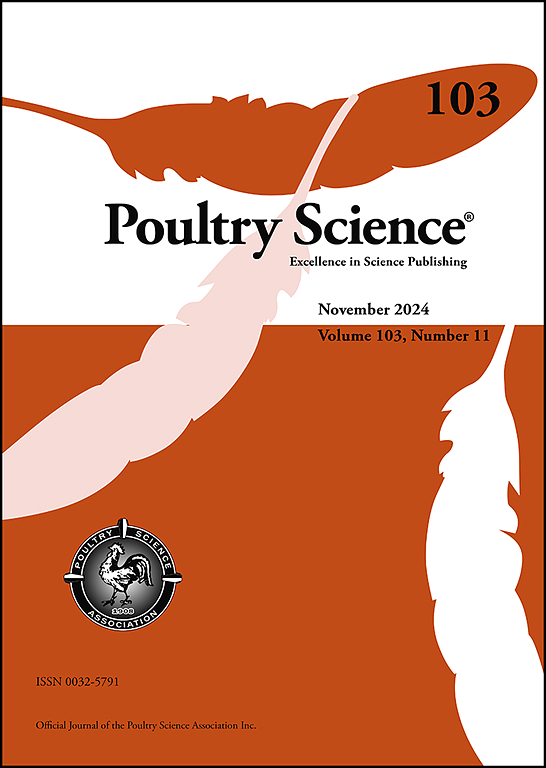Feeding behaviour patterns in relation to body weight and gait in broilers
IF 3.8
1区 农林科学
Q1 AGRICULTURE, DAIRY & ANIMAL SCIENCE
引用次数: 0
Abstract
Collecting data on broiler behaviour patterns in group-housed settings can be challenging, as broilers are difficult to recognize individually. However, broiler behaviour patterns can be valuable for assessing health, welfare and performance. Here, individual feeding patterns of group-housed broilers were studied. Data on feeder visits of 58 randomly selected and subsequently RFID-tagged broilers were used, that were housed in a group of approximately 800 birds in a 45 m2 pen. Feed and water were provided ad libitum, with a total of 16 feeders available to the broilers. All feeders except one (due to farm equipment blocking the access) were fitted with an RFID antenna to detect presence of the broilers at the feeders. The number of feeder visits and feeding durations at the individual level during the period from 20 to 30 d old were examined. In addition, birds’ individual body weights (g) were determined at 14, 21, 27 and 35 d of age, and at 21, 27 and 35 d of age gait scores were determined by experienced observers. The feeders used within the pen (i.e., whether feeding occurred in one area or was spread out across the pen) varied between individuals, and for some birds also changed with age. Furthermore, with higher body weights at 14 d of age, the number of different feeders visited in a day was lower (estimate = -0.011, P = 0.002) and the mean feeding bout duration was higher (estimate = 0.130, P = 0.007). In contrast, larger body weight gain between 14 and 35 d of age was related to more different feeders visited within a day (estimate = 0.028, P = 0.005) and shorter feeding bout durations (estimate = -0.390, P = 0.005). No relationships of feeding descriptors with gait classification were observed. Overall, feeding patterns vary between individual broilers and, given the observed relationships between feeding patterns and weight gain, feeding patterns have potential to be informative for broiler growth in research and commercial conditions.
肉鸡摄食行为模式与体重和步态的关系
在群体饲养环境中收集肉鸡行为模式的数据可能具有挑战性,因为肉鸡很难单独识别。然而,肉鸡的行为模式可用于评估健康、福利和性能。本文对群养肉鸡的个体饲养模式进行了研究。研究人员使用了58只随机选择并随后贴上rfid标签的肉鸡的饲养数据,这些肉鸡被安置在一个45平方米的围栏中,大约有800只鸡。饲料和水的供应是自由的,共有16只饲料供肉鸡使用。除一个喂食器外(由于农场设备阻挡了入口),所有喂食器都安装了射频识别天线,以检测喂食器上肉鸡的存在。研究了20 ~ 30 d饲粮的饲喂次数和饲喂时间。此外,在雏鸟14、21、27和35日龄时测定其个体体重(g),并在21、27和35日龄时由经验丰富的观察员测定其步态评分。在围栏内使用的喂食器(即,喂食是发生在一个区域还是分散在整个围栏中)在个体之间是不同的,对于一些鸟来说,也随着年龄的变化而变化。14日龄体重越高,日采食量越少(估计值= -0.011,P = 0.002),日采食量越长(估计值= 0.130,P = 0.007)。相比之下,14 ~ 35日龄体重增加较大与一天内访问不同喂食者较多(估计= 0.028,P = 0.005)和较短的喂食持续时间有关(估计= -0.390,P = 0.005)。喂食描述符与步态分类没有关系。总体而言,饲养模式因肉鸡个体而异,鉴于观察到的饲养模式与体重增加之间的关系,饲养模式有可能在研究和商业条件下为肉鸡生长提供信息。
本文章由计算机程序翻译,如有差异,请以英文原文为准。
求助全文
约1分钟内获得全文
求助全文
来源期刊

Poultry Science
农林科学-奶制品与动物科学
CiteScore
7.60
自引率
15.90%
发文量
0
审稿时长
94 days
期刊介绍:
First self-published in 1921, Poultry Science is an internationally renowned monthly journal, known as the authoritative source for a broad range of poultry information and high-caliber research. The journal plays a pivotal role in the dissemination of preeminent poultry-related knowledge across all disciplines. As of January 2020, Poultry Science will become an Open Access journal with no subscription charges, meaning authors who publish here can make their research immediately, permanently, and freely accessible worldwide while retaining copyright to their work. Papers submitted for publication after October 1, 2019 will be published as Open Access papers.
An international journal, Poultry Science publishes original papers, research notes, symposium papers, and reviews of basic science as applied to poultry. This authoritative source of poultry information is consistently ranked by ISI Impact Factor as one of the top 10 agriculture, dairy and animal science journals to deliver high-caliber research. Currently it is the highest-ranked (by Impact Factor and Eigenfactor) journal dedicated to publishing poultry research. Subject areas include breeding, genetics, education, production, management, environment, health, behavior, welfare, immunology, molecular biology, metabolism, nutrition, physiology, reproduction, processing, and products.
 求助内容:
求助内容: 应助结果提醒方式:
应助结果提醒方式:


